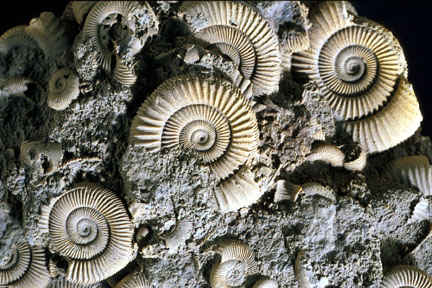......
set: fossils // series: ammonite // picture: DACTYLIOCERAS
The Jurassic seas teemed with ammonites, which came in a whole variety of shapes and sizes. This small species (averaging 65 mm diameter), known as Dactylioceras commune, has a strong, ribbed shell, and probably lived by scavenging on the sea floor. Subsequently, the dead shells have been gently washed up into a shell bank on the margins of the Lower Jurassic sea. Dactylioceras has been collected from almost every continent, and was one of the most successful ammonite lineages ever. Though it eventually died out 180 million years ago, this style of ribbing was copied by numerous subsequent ammonite genera, until the whole group became extinct 65 million years ago. Ammonites are extremely important in biostratigraphy and are studied throughout the Geology degree programmes at Royal Holloway. They form the basis for major research activities by John Wright.